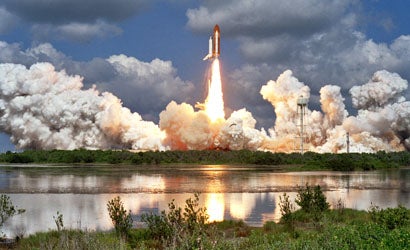My Project: Out to Launch
A young photographer rockets to fame.

One thing people ask about Ben Cooper’s spectacular photos of rocket launches: How does he get that close? (Answer: He doesn’t.) They’re also surprised to learn how old this veteran of launch photography is-he’s 21 and a senior at Embry-Riddle Aeronautical University in Florida, majoring in (you guessed it) aerospace engineering.
So how did a guy from Brooklyn come to photograph launches of space shuttles and unmanned rockets at Cape Canaveral?
“I’ve had a camera in my hand as long as I can remember, starting with a small plastic Olympus when I was a kid,” he says. “I got started in rocket launch photography in 1999, the first time I went to see a Space Shuttle launch. I’ve always had a love for space, too, so the combination of space and photography was a dream come true.”
After moving to Florida for college, Cooper joined the small, close-knit corps of photographers who shoot “remotes” of launches. Most use sound triggers-triggered by VERY LOUD noise-at short distances no human could stand. “My equipment is subjected to not only the elements while waiting-we set our cameras up 12 to 24 hours before the launch-but the ferociousness of the launch itself,” he notes.
“The rocket exhaust comes flying out at tremendous speeds and, if you’re close enough, with extreme heat from the rocket engines. It is also very corrosive when it lands on your camera or tripod-some of the exhaust contains hydrochloric acid, among other things. I’ve lost two lenses so far, most notably an expensive Nikkor 16mm fisheye, for which you can’t fit a good filter on the front. But, like any true photographer, as long as I get the shot, I’m happy!”
And while remote shooters are several miles away at the time of launch, setting up has its share of hazards: mosquito swarms, spiders, poisonous snakes, and alligators.
Cooper uses film cameras primarily-Nikon N2000 and N8008 SLRs-but he is in the process of switching over to digital. His sound triggers are custom-made affairs, using mostly Radio Shack parts. (Ben explains how he makes his remote triggers here.) Remote shooting is restricted to photographers with an accredited media affiliation.
Cooper’s photos have appeared in Aviation Week & Space Technology, Sky & Telescope, and other magazines, as well as on websites like spaceflightnow.com and NASA’s antwrp.gsfc.nasa.gov/apod.
And after graduation? “The more I do photo shoots the more I feel I would be happier doing just that-getting to photograph the way I do and being a part of history at the same time,” he says. “I hope to work at Cape Canaveral or Kennedy Space Center either as an engineer or in the photography/ imaging field-full-time photographer would be the perfect profession.”
And may that be a successful launch.
You can see more of Ben Cooper’s photos at www.launchphotography.com_._